對話記錄工具提供介面,可供瀏覽及分析代理程式與使用者之間的實際對話。這項功能有助於評估代理程式的功能成效,或進行問題除錯。
流程和頁面分析可協助您透過服務專員的流程圖,瞭解流量和升級情形。這項功能可讓代理程式建構者分析流量 (高流量和低流量路徑)、找出問題熱點 (例如找出高升級率),並深入瞭解導致問題的特定網頁和意圖。您可以搭配使用流程和網頁分析,以及對話記錄篩選器,彈性研究相關的流量子集。
限制
如果代理程式很大,載入「流程分析表」和「流程分析圖」檢視畫面可能會很慢。如要縮短載入時間,請使用意圖篩選器和一週的日期範圍。
每場對話最多會記錄 500 個回合。
必要權限
如要使用這項工具,必須具備 dialogflow.conversations 權限。 您可以為自訂角色新增這項權限。此外,管理員角色和其他 Conversational Agents (Dialogflow CX) 角色也適用這項功能。
啟用及停用對話記錄
對話記錄工具會使用互動記錄中的資料。 您可以透過「Enable interaction logging」代理設定,啟用及停用對話記錄。
您也可以使用retention_window_days
安全性設定,控管資料的保留時間。
瀏覽對話記錄
如何使用對話記錄工具:
- 開啟 Dialogflow CX 控制台。
- 選擇專案。
- 選取代理程式。
- 選取「管理」分頁標籤。
- 按一下「對話記錄」。
- 對話會以表格形式列出。
- 您可以選擇使用表格上方的「篩選器」控制項套用篩選器。
- 選取其中一個分頁標籤,本文稍後會說明各分頁標籤。
將對話記錄下載為 CSV 檔案
- 開啟 Dialogflow CX 控制台。
- 選擇專案。
- 選取代理程式。
- 選取「管理」分頁標籤。
- 按一下「對話記錄」。
- 會話群組工作階段會以表格形式列出。
選取對話工作階段,然後按一下「在預覽面板中開啟對話」按鈕:
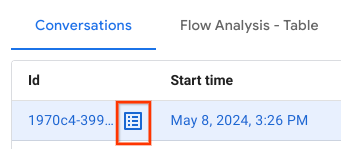
按一下「匯出所有對話」。系統會自動將含有對話的 CSV 檔案下載到電腦。最多只能下載 50 則對話。如果所選對話工作階段包含超過 50 個對話,下載作業就會失敗。
對話
對話會以兩種檢視畫面顯示:對話摘要檢視畫面和對話詳細資料檢視畫面。
對話摘要檢視畫面
對話摘要檢視畫面會列出所有對話。 系統會為每個對話提供下列中繼資料:
| X | 項目 |
|---|---|
| 對話 ID | 對話的 ID |
| 時間長度 | 對話時間長度 |
| 轉彎 | 對話輪次數 |
| 管道 | 對話 (文字)、語音或未定 (對話尚未收到任何使用者輸入內容) |
| 語言 | 對話的語言 |
| 環境 | 代理程式的環境 |
| 開始時間 | 對話開始時間 |
| 旗標 | 可能設為「轉交真人客服」 (如果對話已轉交給真人客服)、「已放棄」 (如果使用者離開未完成的對話) 或「TU、TD」 (如果對話中的回覆獲得使用者評分) |
您可以依中繼資料 (環境和時間長度除外) 篩選結果, 以及使用下列其他篩選選項:
| X | 項目 |
|---|---|
| Intent | 在對話的某個時間點,系統比對成功了提供的意圖 |
| 不相符 | 部分對話回合導致意圖不相符 |
| 心流狀態 | 提供的流程是某些對話回合結束時的最終有效流程 |
| 頁面 | 在某些對話回合結束時,系統會提供最終的有效頁面 |
| 是否為真人服務專員交接 | 已設定「真人服務專員轉接」旗標 |
| 已捨棄 | 已設定「已放棄」旗標 |
| 對話 ID | 選擇特定對話 |
| 開始時間 | 提供日期範圍 |
| 服務專員話語 | 提供的文字是代理程式在對話中使用的語音子字串。子字串必須包含語音中出現的完整字詞 (以空格字元或任一端為界)。 |
| 使用者話語 | 提供的文字是使用者在對話中某個時間點使用的語音子字串。子字串必須包含語音中出現的完整字詞 (以空格字元或任一端為界)。 |
| 有喜歡意見回饋 | 對話中的回覆獲得「按讚」回饋,系統會設定 TU 旗標 |
| 有「不喜歡」意見回饋 | 對對話中的回覆提供「不喜歡」意見回饋,系統會設定 TD 旗標 |

對話詳細資料檢視畫面
您可以在對話詳細資料檢視畫面中,瀏覽特定對話的逐輪檢視畫面。每一回合對話都會提供使用者訊息、代理程式訊息,以及下列中繼資料:
| X | 項目 |
|---|---|
| Intent | 相符的意圖顯示名稱或「沒有相符項目」 |
| 頁面 | 最終有效頁面名稱 |
| 心流狀態 | 最終啟用的流程名稱 |
| 參數 | 在對話期間收集的參數 |
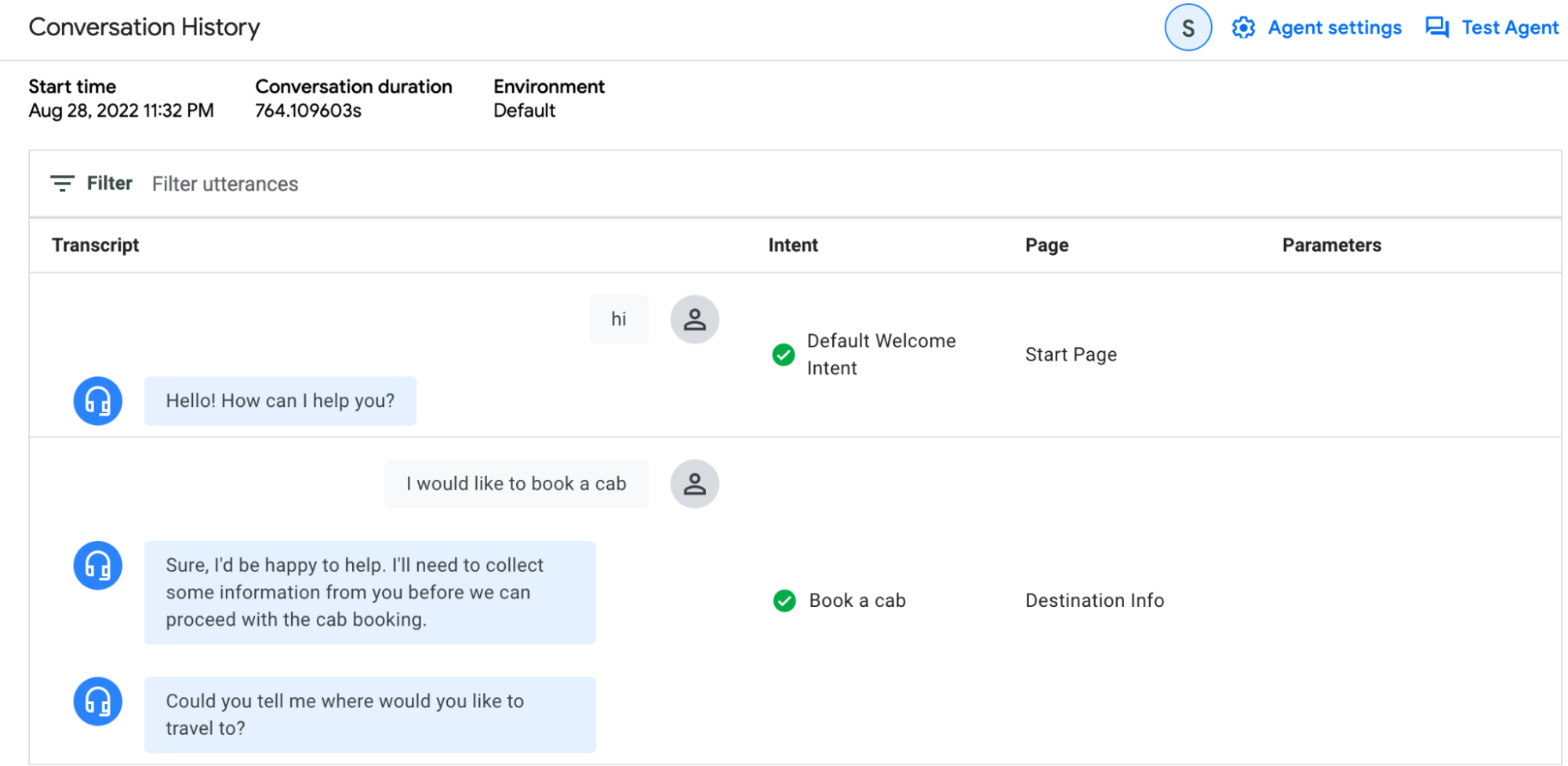
用途範例
這項工具可找出導致問題轉給真人客服專員的代理程式問題。在對話摘要檢視畫面中,您可以套用「是否為真人服務專員交接」篩選器,並選取「是」。 請檢查這些對話,並找出常見模式。舉例來說,您可能會發現大部分對話中,特定網頁的回合都有不相符的標記。這表示需要建立意圖路徑,或現有意圖路徑不在範圍內。
流程分析表
「流程分析 - 表格」分頁標籤可用於分析流程和網頁中的流量和離開次數,並以表格形式呈現。
系統會顯示下列指標:
| X | 項目 |
|---|---|
| 流程名稱 | 代理程式中每個流程的流程名稱 |
| 相對流量 | 透過這個流程進行的對話次數 |
| 提報率 | 在所有經過這個流程的對話中,要求轉交專人處理的對話所占百分比 |
| 離開率 | 在所有經過此流程的對話中,有多少百分比的對話在此流程後結束或從此流程轉換為 SESSION_END |
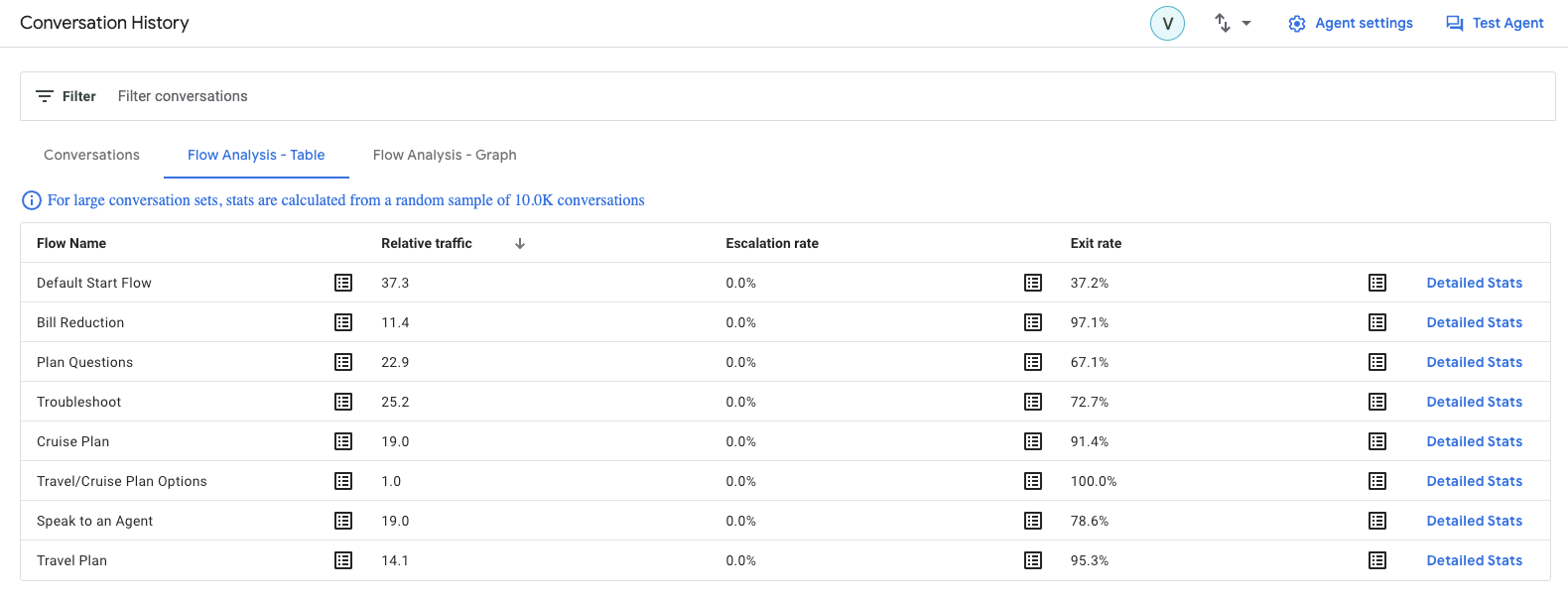
按一下清單 按鈕,即可開啟該列的相關對話範例。您可以詳閱範例,進一步瞭解具體且細微的問題。 舉例來說,您可以檢查發生升級的原因。如要查看樣本的完整詳細資料,請按一下「對話詳細資料」連結。
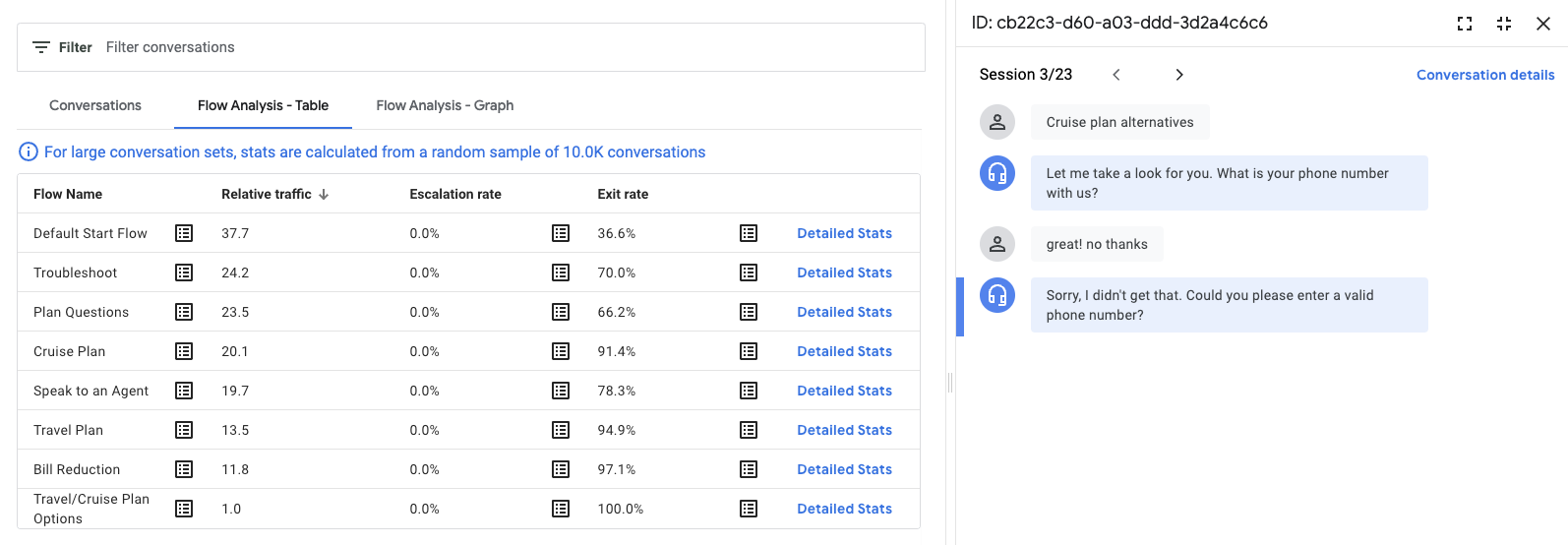
按一下流程的「詳細統計資料」,即可開啟流程的流量統計資料。 這會顯示所選流程的流程轉換統計資料。
系統會顯示下列指標:
| X | 項目 |
|---|---|
| 下一個流程 | 從所選流程轉換至其他流程的統計資料 |
| 上一個流程 | 從其他流程轉換至所選流程的統計資料 |
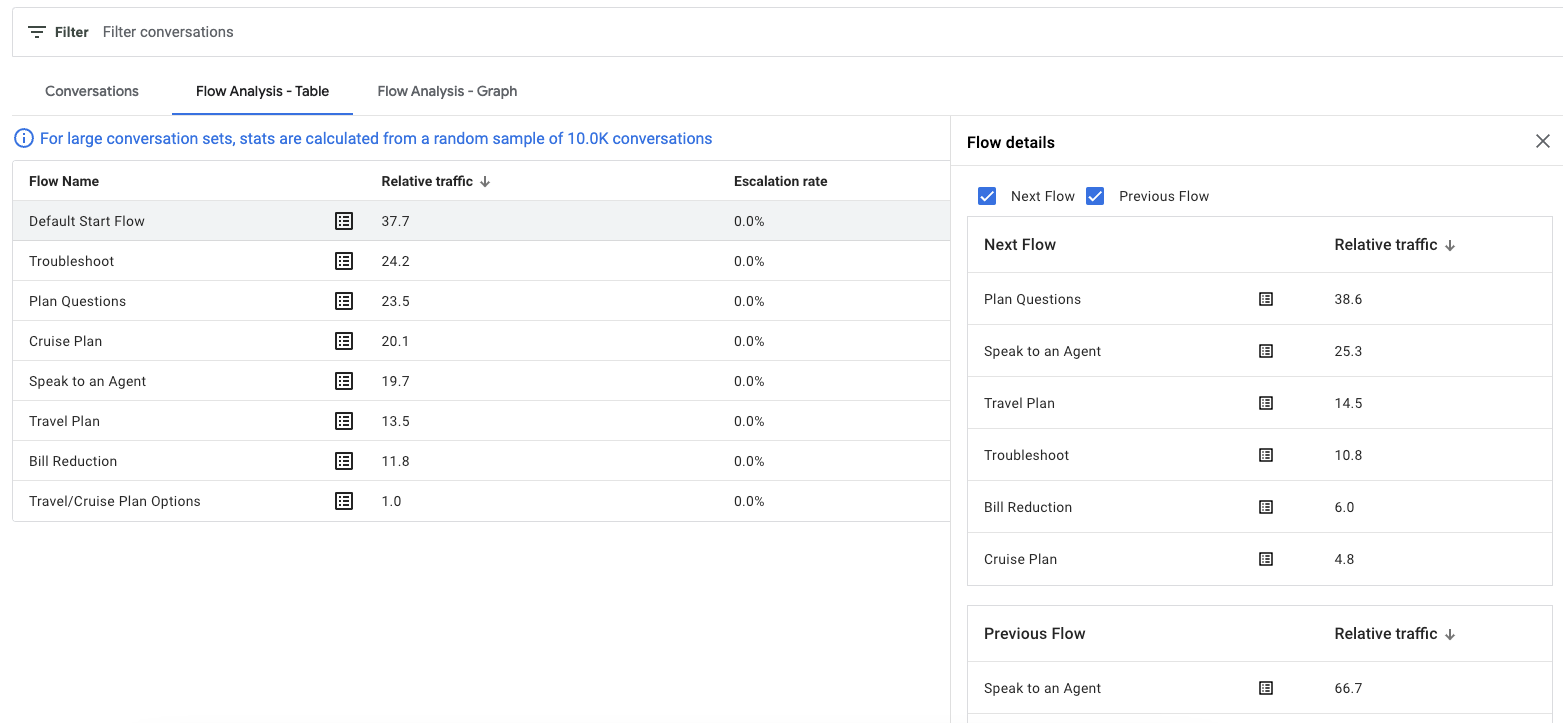
點選任一流程列,即可深入瞭解影響該流程的網頁。
系統會顯示下列指標:
| X | 項目 |
|---|---|
| 相對流量 | 造訪這個網頁的對話數量。 |
| 提報率 | 在所有造訪這個頁面的對話中,要求轉交給專員處理的對話所占的百分比 |
| 離開率 | 在造訪這個頁面後直接結束流程或工作階段 (END_SESSION) 的對話所占百分比,計算基準為所有造訪這個頁面的對話 |
| 不相符率 | 所有造訪這個頁面的對話中,沒有相符結果的對話所占百分比 |

按一下頁面的「詳細統計資料」,即可開啟頁面的流量統計資料。這會顯示所選頁面的網頁轉換統計資料。
系統會顯示下列指標:
| X | 項目 |
|---|---|
| Intent | 網頁意圖相符的統計資料 |
| 下一頁 | 從所選頁面轉換至其他頁面的統計資料 |
| 上一頁 | 從其他頁面轉換至所選頁面的統計資料 |
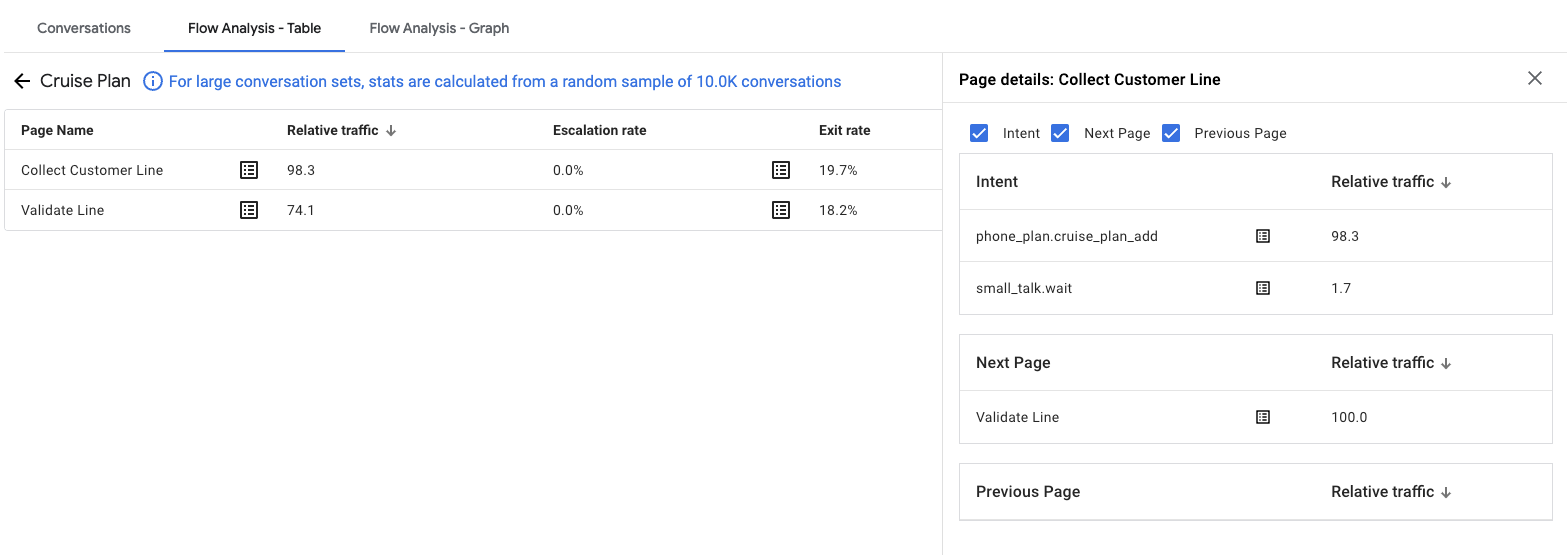
流程分析圖表
「流程分析 - 圖表」分頁標籤會以圖表形式,分析流程和網頁中的流量和離開次數。
按一下任一流程,即可深入瞭解流程中網頁的流量。
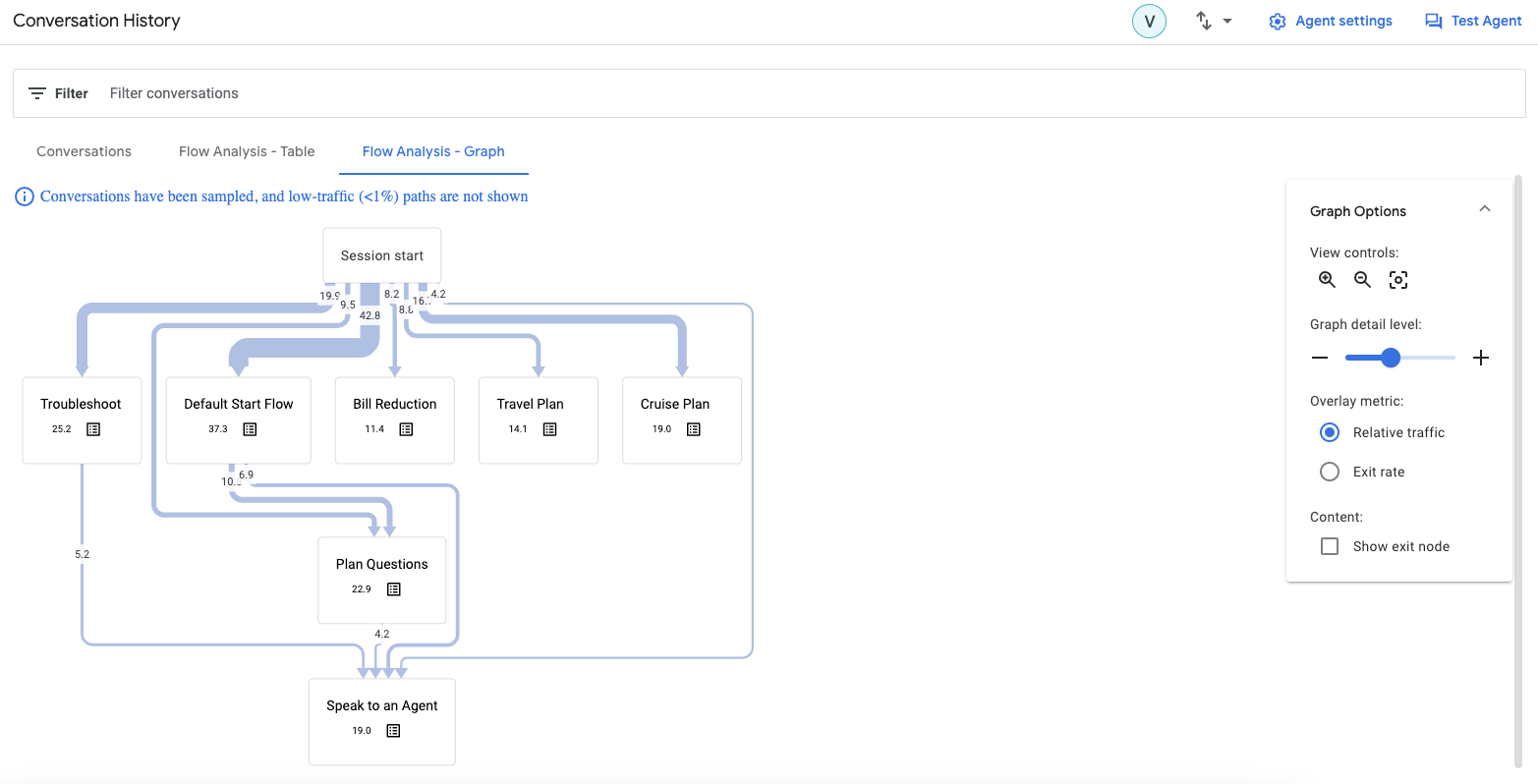
你可以使用縮放滑桿,調整圖表上顯示的詳細程度。在較低的設定下,低量路徑會從視覺化效果中捨棄。 即使設定較高,音量極低的音軌一律會隱藏。
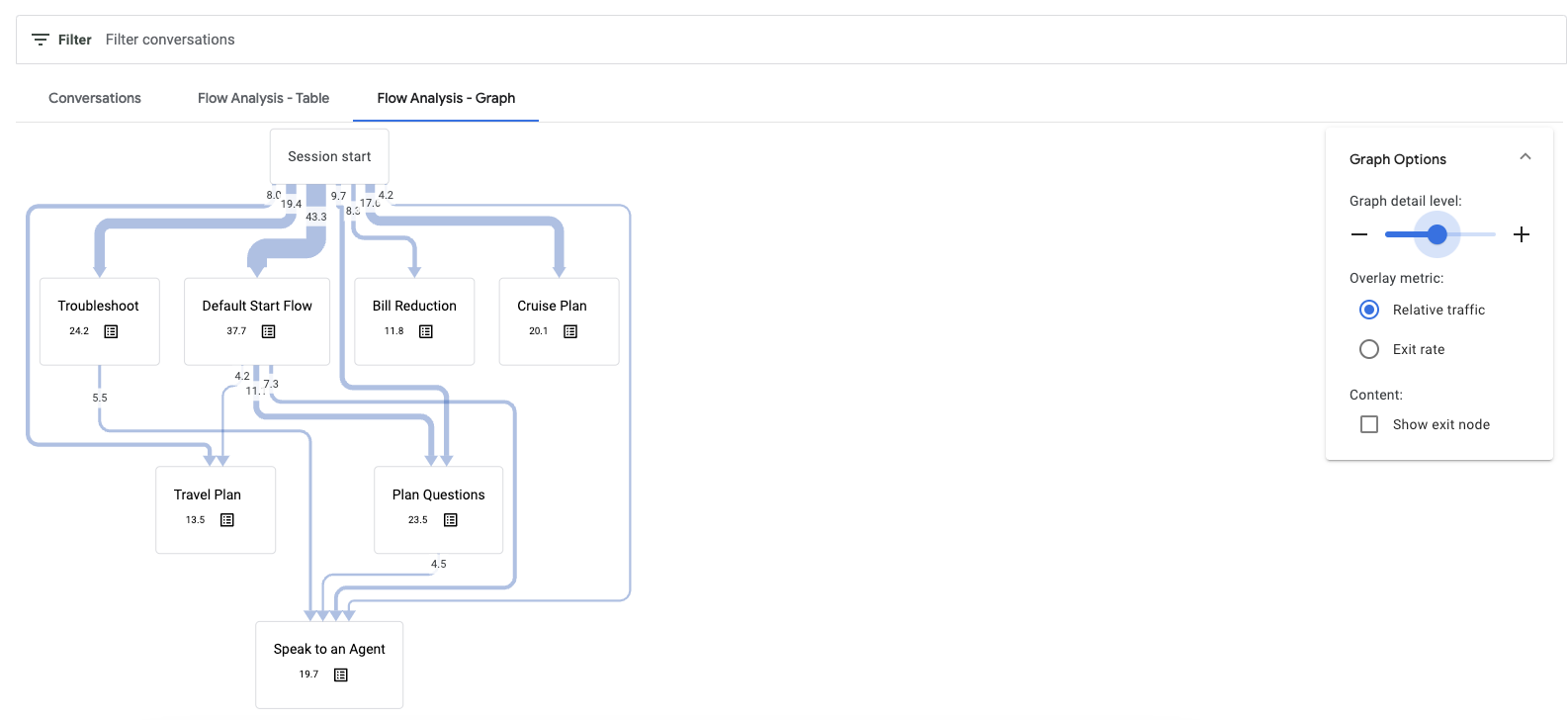
指標會以顏色標示,方便您找出嚴重程度較高的問題。
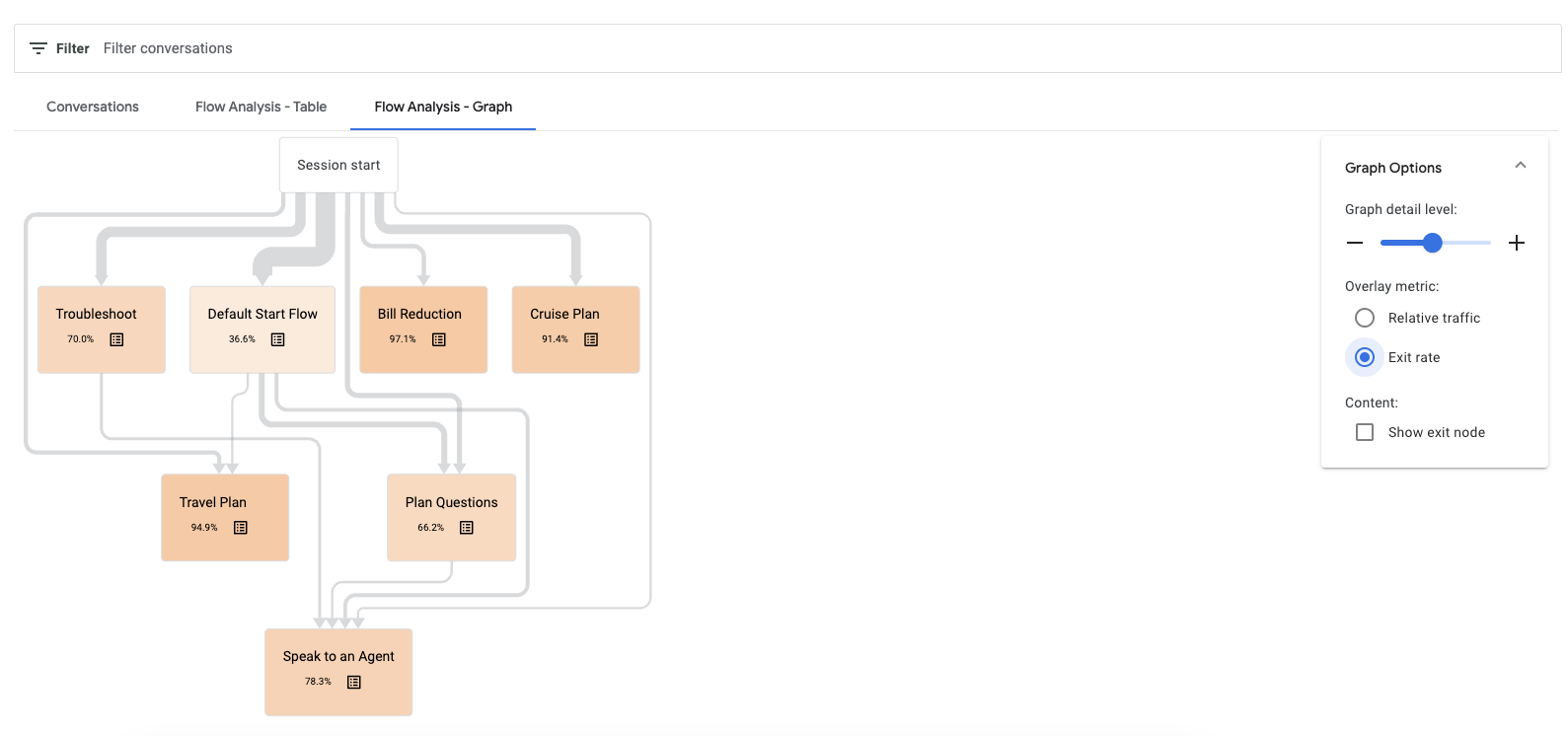
按一下清單 按鈕,即可查看相關對話。

點選任一流程,即可前往該流程中的頁面。這裡會顯示更多疊加指標:相對流量、不相符率、升級率和退出率。
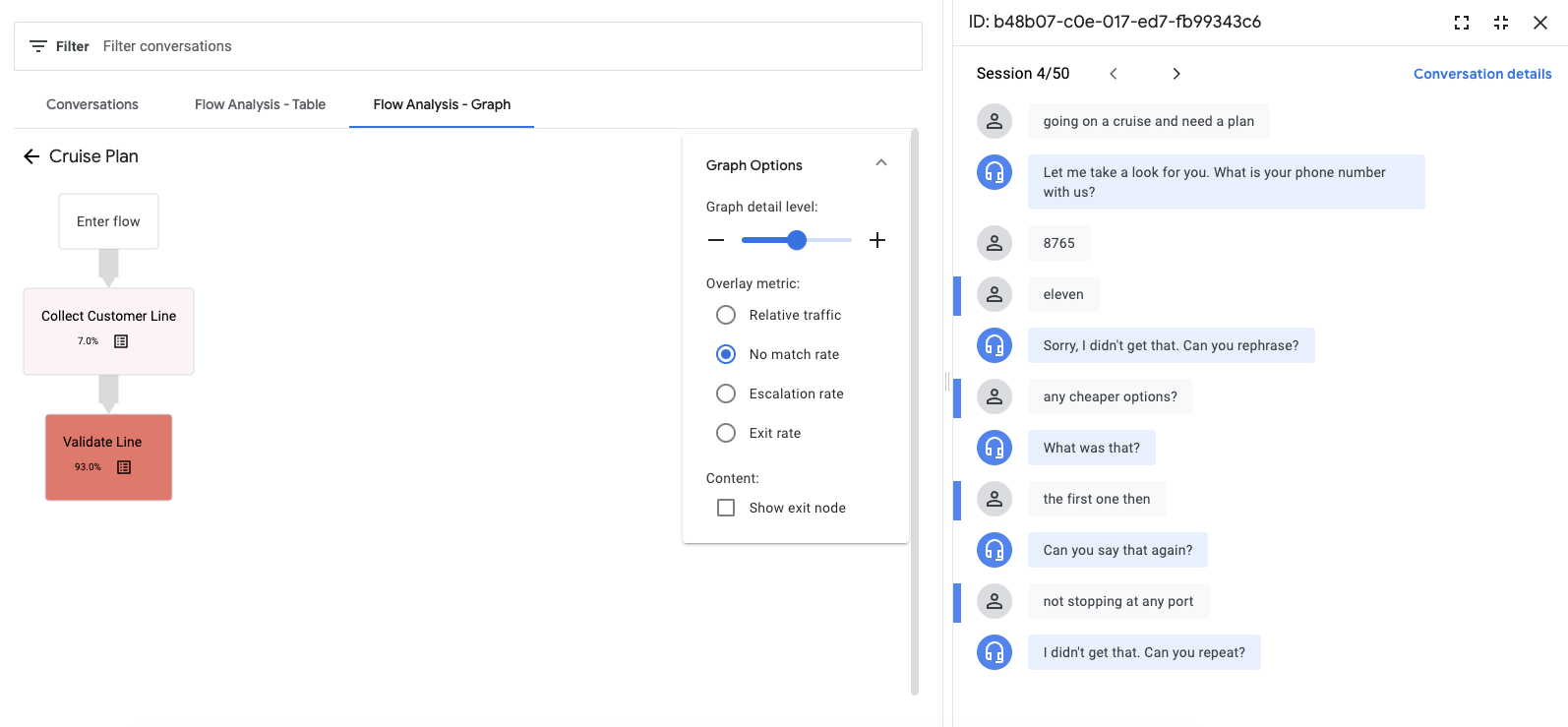
透過 API 存取對話記錄
您可以使用 API 存取對話記錄。請參閱 V3beta1 參考說明文件。
隱私權
啟用對話記錄後,Google 會收集並儲存一段時間的對話資料,然後永久刪除。預設為 365 天,但您可以使用 SecuritySettings 中的 retention_window_days 欄位縮短這段時間。
資料儲存期間,您保有完整擁有權。Google 不會將您的資料用於客戶支援以外的任何用途,也不會存取這些資料。

